Top of mind in 2024 were the far-reaching impacts of climate displacement, zoning as a solution to the housing crisis, and the potential for safer roads and better public transit in American cities.

The challenges facing cities in 2024 are often not new. But they are, in many cases, more urgent. Traffic fatalities continue to increase in many cities despite pledges by civic leaders to support Vision Zero goals, while transportation agencies keep expanding highways and prioritizing traffic flow over safety and sustainability. Climate change continues to impact homes and infrastructure in coastal communities and areas previously considered ‘climate havens.’ Housing costs continue to strain a growing number of households, while restrictive zoning codes limit new housing development and induce unsustainable sprawl.
This year’s books tackle these issues from a variety of perspectives. One author argues that zoning, which is blamed for so many restrictive policies and stifled development, can be used as a force of good to shape more affordable, healthier, and more livable cities. Another book outlines examples of missing middle housing around the country, showing how typologies that are often prohibited by present-day zoning codes have been part of the American urban fabric for centuries. From understanding the role that sports stadiums play in urban development to how climate change will increasingly limit where people can live to a renewed call for walkable cities and safe streets, you’ll find a breadth of subjects on this year’s list.
History plays a prominent role on this list, too. One book takes the reader through the colorful history of Austin, Texas, while another presents beautifully illustrated maps of past, present, and never-realized U.S. transit systems in a wide-ranging history of transit development (along with a call to action to realize the transit visions that are still possible). Yet another takes you on a national, historical tour of Black cities, while one author zeroes in on the fight to preserve languages in New York City.
Please note that this list — named in no particular order — only includes books published between roughly November 2023 and October 2024. Books published in the last part of the year will be evaluated for next year’s list. Think we missed any outstanding books from this past year? Let us know!
Building the Black City: The Transformation of American Life
Joe William Trotter, Jr.
University of California Press
October 29, 2024, 304 pages
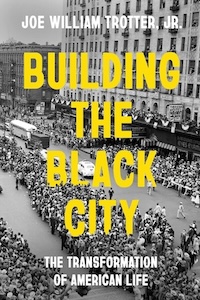 In what the author calls a companion to his 2019 book, Workers on Arrival: Black Labor in the Making of America, which details the key role played by Black workers in building American cities, Joe William Trotter, Jr. traces the development of Black “cities-within-cities” in the United States as African Americans created thriving communities that set the stage for the end of slavery and the Civil Rights movement.
In what the author calls a companion to his 2019 book, Workers on Arrival: Black Labor in the Making of America, which details the key role played by Black workers in building American cities, Joe William Trotter, Jr. traces the development of Black “cities-within-cities” in the United States as African Americans created thriving communities that set the stage for the end of slavery and the Civil Rights movement.
From cemeteries to churches to business districts, Black Americans built spaces that bolstered the community in the face of segregation and oppression. The book highlights cities in each region of the country, showing how the people that built some of the nation’s key infrastructure and institutions were often denied access to those resources themselves and how Black Americans formed their own parallel social and physical infrastructure as they moved with the nation’s Westward migration.
Even before the end of slavery in the United States, Black communities formed strong networks that “used a variety of overlapping economic, political, and institutional events to press their claims for emancipation, access to property, citizenship rights, and opportunities to build their own families and communities.” As the post-Civil War Great Migration continued, Trotter explains how Black communities overlapped and interacted with Latino communities and other migrants seeking new opportunities in the growing cities of the Southwest and the Pacific Northwest.
To conclude, Trotter outlines the changes brought on by the postindustrial era and the broader social and economic movements of the late 20th century. Today, along with a turn to the suburbs, Black communities are once again forming in old central city neighborhoods. For Trotter, the book is both a deep documentation of Black urban life and a call for reparations and restorative justice that acknowledges of role Black Americans in building the U.S. economy and shaping vibrant cities.
Key to the City: How Zoning Shapes Our World
Sara Bronin
W.W. Norton & Company
October 1, 2024, 240 pages
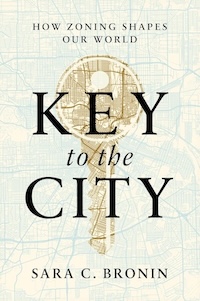 Lawyer and zoning reform advocate Sara Bronin explains how zoning codes have the power to shape what kind of housing gets built and where, and why zoning reform is arguably the most powerful tool for unlocking housing affordability and building more livable places.
Lawyer and zoning reform advocate Sara Bronin explains how zoning codes have the power to shape what kind of housing gets built and where, and why zoning reform is arguably the most powerful tool for unlocking housing affordability and building more livable places.
But it’s not just about housing. Delving into the myriad ways zoning shapes access to resources — from healthcare to education to transportation — Bronin shows that zoning is a powerful tool for promoting public health, affordability, and equity. The decisions that influence the built environment can have consequences for public health; without a walkable environment or access to transit, people are forced into a car-dependent, costly, and unhealthy lifestyle.
“The paradox of zoning — the tragedy of zoning — is that it often starts out in a hopeful attempt to improve our cities and the lives we live in them,” Bronin writes. And while it often fails, Bronin argues that zoning can also succeed in guiding thoughtful, sustainable development. Rather than calling for a wholesale abolition of zoning, Bronin — who grew up in famously zoning-less Houston — argues for “zoning for good.” Bronin acknowledges the genesis of zoning in the early 20th century, when policymakers started recognizing the negative impacts that large-scale industrial uses had on surrounding neighborhoods, but argues that regulations should be far more lax for the “craftsman industrial” home businesses of today.
Bronin may be putting too much stock in the ability of the public sector to create and enforce the types of zoning laws she envisions without creating the same restrictive environments and high permitting costs that developers see today. But her own experience as chair of a planning and zoning commission, along with examples she provides from other cities, shows that incremental change can be possible.
A Paradise of Small Houses: The Evolution, Devolution, and Potential Rebirth of Urban Housing
Max Podemski
Beacon Press
March 26, 2024, 272 pages
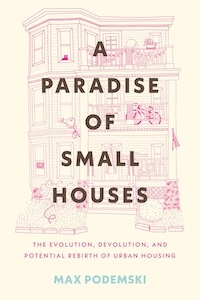 Planner and first-time author Max Podemski pulls off a threefold coup in A Paradise of Small Houses. First, he manages to connect wildly disparate North American cities through a substantial, non-contrived theme: missing middle housing. Second, he celebrates, with utmost sincerity, a diversity of regional vernacular building types, tying them to not only local fashions but also to local regulations. Third, he illustrates the important but often vague concept of “missing middle” with uncommon vividness. The result is a celebration of an enormous but often unheralded segment of the housing supply and inspiration for future planning.
Planner and first-time author Max Podemski pulls off a threefold coup in A Paradise of Small Houses. First, he manages to connect wildly disparate North American cities through a substantial, non-contrived theme: missing middle housing. Second, he celebrates, with utmost sincerity, a diversity of regional vernacular building types, tying them to not only local fashions but also to local regulations. Third, he illustrates the important but often vague concept of “missing middle” with uncommon vividness. The result is a celebration of an enormous but often unheralded segment of the housing supply and inspiration for future planning.
Podemski highlights nine cities — including Boston (triple-deckers), Philadelphia (row houses), Los Angeles (dingbats), Houston (townhouses), and his native Portland (bungalows) — to figure out how cities accommodated diverse, growing populations in their respective heydays. In the process, he discusses economic, cultural, historical, and, of course, regulatory forces that encouraged and accommodated each city's respective styles. Podemski insists that none of these past trends provides a blueprint for the future or that one city ought to copy another’s vernacular style. And, yet, there's plenty of inspiration to be found for planners who believe that cities are for everyone and that new market-rate housing does not always need to favor the wealthy.
Free the Land: How We Can Fight Poverty and Climate Chaos
Audrea Lim
St. Martin’s Press
June 25, 2024, 320 pages
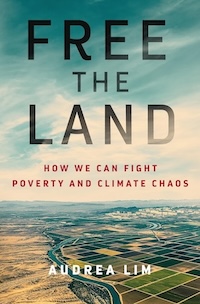
Audra Lim's Free the Land is a bit like augmented reality. Everywhere you look -- at least in the United States -- becomes multilayered and annotated. No piece of ground goes untouched, whether it's private property, a public right of way, or government-owned open space. With an intellectual (but not inaccessible) bent, Lim, a freelance journalist, interrogates the history of land ownership and the palimpsest of ideas and justifications that render it a commodity under our capitalist system and regulatory structures. She goes back to John Winthrop, Thomas Jefferson, and the waves of colonization that turned what had been Indigenous homelands into territories and jurisdictions.
Lim touches on thorny issues like reparations and the use, and abuse, of land to create senses of belonging and exclusion, especially along racial lines. In the urban chapters, Lim discusses progressive ideas--most of which have never caught on--such as community land trusts and housing schemes that do not involve ownership or landlords. And she discusses a multitude of ways that natural lands have been degraded, plus a few isolated solutions. Lim's strength lies in her equal attention to history, economics, and the 2020s status quo that have combined to confer great privilege on a few and mediocrity on many.
On the Move: The Overheating Earth and the Uprooting of America
Abrahm Lustgarten
Farrar, Straus and Giroux
March 26, 2024, 336 pages
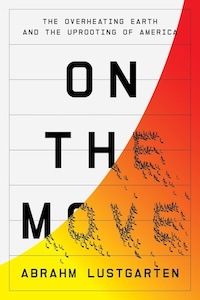 In On the Move, Abrahm Lustgarten documents the growing need for people and communities to relocate as climate change makes some places dangerous or unlivable. “The places around the world we think we can live in now will not be the same as the places where we will be able to live in the future,” Lustgarten writes. Today, millions of Americans live in flood-prone zones or wildfire areas, where the risk has been mitigated by cheap insurance — until now, when insurance companies are spiking rates or leaving some states altogether.
In On the Move, Abrahm Lustgarten documents the growing need for people and communities to relocate as climate change makes some places dangerous or unlivable. “The places around the world we think we can live in now will not be the same as the places where we will be able to live in the future,” Lustgarten writes. Today, millions of Americans live in flood-prone zones or wildfire areas, where the risk has been mitigated by cheap insurance — until now, when insurance companies are spiking rates or leaving some states altogether.
Lustgarten combines migration models with his reporting work and personal experience to paint a portrait of a population on the brink of massive displacement. For many households, it will soon be time to decide whether to stay or go — and if so, where. Communities less affected by climate disasters will have to contend with displaced neighbors seeking new homes.
For the solutions-oriented, Radical Adaptation: Transforming Cities for a Climate Changed World by Brian Stone, Jr. takes a deep dive into the impacts of extreme heat, drought, and flooding and offers suggestions for addressing challenges using expansive case studies focusing on heat, water (too much of it and too little), and retreat, showing how cities can engage in managed retreat as certain areas become unlivable.
Urbanist writing includes no shortage of (often repetitive) perspectives on climate change. Madeline Orr's brilliantly titled Warming Up: How Climate Change is Changing Sport offers a refreshing take: the influence of rising temperatures, rising ocean, and general climate chaos on sports. Her discussion is not confined to cities as such. But, insofar as sports — from recreational to professional — are a massive part of city life, the potential for disruption and cancellation, and the need for adaptation, must be on planners' minds.
The Stadium: An American History of Politics, Protest, and Play
Frank Andre Guridy
Basic Books
August 20, 2024, 368 pages
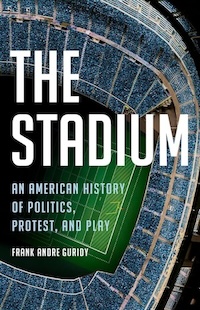 Over the past few decades, when planners have focused on athletic stadiums -- including indoor arenas, outdoor or domed large stadiums, and the like -- they have often focused on placemaking, meaning the ways that stadiums can stimulate development, commerce, and human activity in their respective vicinities, be they in urban cores or suburban fringes. On occasion, planners might contemplate the massive public and private expenditures that stadiums consume. The Stadium focuses on a more obscure component: the social and symbolic importance of stadiums, on both national and local scales. Columbia University history professor Frank Andre Guridy argues that, in modern America, stadiums take on many functions of the proverbial "town square." In that sense, The Stadium is an implicit critique of the many cities that do not have functioning town squares or other genuine communal spaces.
Over the past few decades, when planners have focused on athletic stadiums -- including indoor arenas, outdoor or domed large stadiums, and the like -- they have often focused on placemaking, meaning the ways that stadiums can stimulate development, commerce, and human activity in their respective vicinities, be they in urban cores or suburban fringes. On occasion, planners might contemplate the massive public and private expenditures that stadiums consume. The Stadium focuses on a more obscure component: the social and symbolic importance of stadiums, on both national and local scales. Columbia University history professor Frank Andre Guridy argues that, in modern America, stadiums take on many functions of the proverbial "town square." In that sense, The Stadium is an implicit critique of the many cities that do not have functioning town squares or other genuine communal spaces.
Guidry refers to, but does not belabor, the role of public finance in stadium construction, which has often been described as a raw deal for cities. He focuses largely on what happens when mass groups of people assemble, for sporting events, of course, but also for concerts, trade shows, and political rallies. Each, he argues, influences attitudes, mores, and cultural norms. He invokes everything from the notorious 19TK Nazi rally at New York's Madison Square Garden to Colin Kaepernick's more recent kneeling protests against police brutality and the even more recent renaming of the Washington Redskins. He decries the ways that cities have allowed big business — especially team owners — to exploit and manipulate their host municipalities. With the stadium-building boom proceeding apace, planners who aid and influence these projects must bear in mind that they are more than just venues for lighthearted fun.
Language City: The Fight to Preserve Endangered Mother Tongues in NYC
Ross Perlin
Atlantic Monthly Press
February 20, 2024, 432 pages
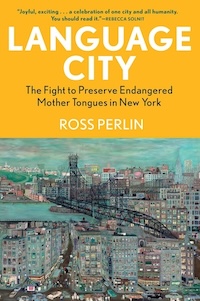 City life in the United States almost always involves different languages. Overhearing an unfamiliar tongue is nothing unusual; indeed, it's part of what makes cities great. Perhaps no one knows that better than author Ross Perlin, a linguist and the co-director of the non-profit Endangered Language Alliance. Perlin's city is New York, which means that he's not discussing a handful of languages, or even a few dozen. He's discussing hundreds, from world languages like Spanish and Mandarin to some of the most endangered languages in the world. Indeed, some language communities are thriving more readily in single apartment buildings in Queens or Brooklyn than they do in their home territories. His is an unusual, and unusually compelling glimpse into urban diversity while, at the same time, shedding light on global forces like migration and, in too many places, ethnic homogenization.
City life in the United States almost always involves different languages. Overhearing an unfamiliar tongue is nothing unusual; indeed, it's part of what makes cities great. Perhaps no one knows that better than author Ross Perlin, a linguist and the co-director of the non-profit Endangered Language Alliance. Perlin's city is New York, which means that he's not discussing a handful of languages, or even a few dozen. He's discussing hundreds, from world languages like Spanish and Mandarin to some of the most endangered languages in the world. Indeed, some language communities are thriving more readily in single apartment buildings in Queens or Brooklyn than they do in their home territories. His is an unusual, and unusually compelling glimpse into urban diversity while, at the same time, shedding light on global forces like migration and, in too many places, ethnic homogenization.
Perlin describes the spaces where immigrant languages thrive and vectors by which they converge on a single five-boroughed city, and he provides intimate portraits of six New Yorkers who each speak different, endangered languages: Seke (Nepal), N'ko (west Africa), Nahuatl (Mexico), Wakhi (central Asia), Yiddish (Europe), and, not least, Lenape (Manhattan) -- still spoken by exactly one person. Perlin's goal is to help speakers and languages thrive -- and not be assimilated or marginalized. It's a tall order, but it's a task that great cities can rise to and that great planners can contribute to. Indeed, they must. Perlin equates linguistic diversity with many other forms of diversity--including the diversity of thought and ambition that leads to economic development. “The future of the city's professional and subcultural diversity may seem comparatively assured,... but this too ultimately relies on the city’s linguistic and cultural diversity,” writes Perlin.
Lost Subways of North America: A Cartographic Guide to the Past, Present, and What Might Have Been
Jake Berman
University of Chicago Press
November 3, 2023, 272 pages
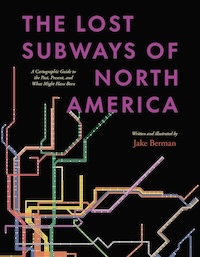 Rarely do fun and lamentation share pages so intimately as they do in The Lost Subways of North America. Jake Berman — who is an unlikely combination of writer, lawyer, and cartographer — tells the history of rail transit in 23 North American cities through a delightful combination of graphics and text. He recreates archival maps with modern graphic design techniques to illustrate how cities' transit systems evolved and, most poignantly, how they stopped short or regressed. The “lost” subways include rail lines, such as Los Angeles’ famed Red Car system, that used to exist but were torn up and decommissioned, as well as planned lines, such as suburban extensions for Atlanta's MARTA, that were never built.
Rarely do fun and lamentation share pages so intimately as they do in The Lost Subways of North America. Jake Berman — who is an unlikely combination of writer, lawyer, and cartographer — tells the history of rail transit in 23 North American cities through a delightful combination of graphics and text. He recreates archival maps with modern graphic design techniques to illustrate how cities' transit systems evolved and, most poignantly, how they stopped short or regressed. The “lost” subways include rail lines, such as Los Angeles’ famed Red Car system, that used to exist but were torn up and decommissioned, as well as planned lines, such as suburban extensions for Atlanta's MARTA, that were never built.
By visualizing lines that should have, and could have, been built, Berman argues that “a uniquely North American combination of dysfunctional politics, the desire to reshape the metropolis for the automobile, and the law of unintended consequences” have rendered our cities vastly less mobile and less functional than they ought to have been. More than just a graphically pleasing trip down memory lane, Lost Subways is a call to action for planners: even if there is no time like the present to implement active transit, create more walkable and rollable communities, and, maybe, turn some of those old maps into realities.
Lost in Austin: The Evolution of an American City
Alex Hannaford
Dey Street Books
October 1, 2024, 240 pages
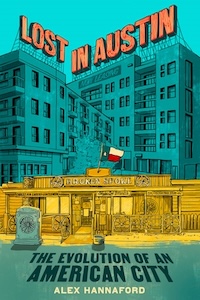 Everyone is probably sick of Austin by now. Even, and especially, Alex Hannaford. And yet, Austin's story is an important one. It is the major American boom town of the 2010s, and, befitting his subject, Hannaford has written a lively and amusing, and not un-critical account of its rise. It's a worthy addition to the relatively short list of excellent urbanographies about American cities.
Everyone is probably sick of Austin by now. Even, and especially, Alex Hannaford. And yet, Austin's story is an important one. It is the major American boom town of the 2010s, and, befitting his subject, Hannaford has written a lively and amusing, and not un-critical account of its rise. It's a worthy addition to the relatively short list of excellent urbanographies about American cities.
Though Lost in Austin is well-researched, Hannaford, a longtime journalist, is not an unbiased researcher. Lost in Austin is based in large part on his own migration to the city, in 2009, along with hundreds of thousands of others who caused the city to grow from around 800,000 to over 950,000 in the 10 years he lived there. Having moved away in 2019, his perspective is an informed outsider: dazzled, bemused, and searching for the essence of what he's observing. He's also self-critical, counting himself among the "gentrifiers" who have driven up the cost of living and made life even harder for marginalized populations. Hannaford laments the loss or dilution of elements that used to make Austin special: its vaunted "weirdness," creativity, socioeconomic diversity, and relative obscurity. Even Austin's famous party and live music scene has, in Hannaford's description, been overwhelmed by its own branding. He also takes aim at the invasion of the tech industry, led by uber-bros Joe Rogan and Elon Musk. And then there's the development: high-rises, sprawl, and everything in between.
There is, as ever, a fine line in American urbanism between prosperity and insufferableness. Lost in Austin is a vivid tale — still unfolding — that other cities can look to for inspiration — or caution.
The traffic safety crisis
Despite growing evidence about how the design of roads and vehicles impacts traffic safety, changes in U.S. traffic engineering and transportation policy are still happening at a glacial pace. Traffic deaths in the United States remain at higher numbers than before the pandemic; The National Highway Traffic Safety Administration estimates that 18,720 people died in car crashes in the first half of 2024.
Transportation experts like Jarrett Walker have been sounding the alarm for years. This year, Acknowledging the massive changes society has undergone since the 2011 publication of his massively popular Human Transit: How Clearer Thinking about Public Transit Can Enrich Our Communities and Our Lives, Walker expanded his book in this year’s revised edition to address issues such as remote work, transportation demand companies and the tech ‘disruption’ of transit, and social justice. Walker adds three brand new chapters, including one on the importance of freedom of mobility and access to opportunity as “not just as a feel-good word but as a thing we can measure and plan for,” as well as new content throughout the book.
Professor Wes Marshall’s provocatively titled book, Killed by a Traffic Engineer: Shattering the Delusion that Science Underlies our Transportation System, explains how transportation engineering has contributed to the traffic safety crisis, building roads that are conducive to high-speed driving and lack safe pedestrian infrastructure.
Marshall asserts that traffic engineers often rely on research that is outdated or irrelevant. In fact, many standards applied by U.S. transportation departments — such as 12-foot widths for travel lanes — are based on old research that doesn’t take safety into account. Other design choices, such as giving “pedestrians the walk signal while we simultaneously allow drivers to turn directly into where we just told pedestrians they could safely walk,” can make intersections more dangerous and encourage risky behavior.
We will never eliminate some amount of human error on our roads, but Marshall argues that thoughtful design and engineering choices can have a major impact on how much harm it will cause. Marshall’s book adds to the growing body of literature calling out for systemic change — if only U.S. transportation agencies and policymakers would listen.
15-minute cities under attack
Few ideas in urbanism have gotten as much attention as that of the “15-Minute City,” which was popularized by Carlos Moreno, a professor at Le Sorbonne in Paris. Unfortunately, Moreno's book, The 15-Minute City: A Solution to Save Our Time and Our Planet, though important insofar as it reflects the 15-minute trend, is disappointing. It lacks energy and is weighed down by bureaucratic language and awkwardly structured chapters. In case studies on Paris; Busan, Korea; and Portland, Oregon, among others — Moreno almost seems to take credit for what were, in many cases, perfectly functional cityscapes long before he came along. An arguably stronger, and more readable, take is Shrink The City: The 15-Minute Urban Experiment and the Cities of the Future, by Financial Times correspondent Natalie Whittle.

Planetizen Federal Action Tracker
A weekly monitor of how Trump’s orders and actions are impacting planners and planning in America.

Chicago’s Ghost Rails
Just beneath the surface of the modern city lie the remnants of its expansive early 20th-century streetcar system.

Amtrak Cutting Jobs, Funding to High-Speed Rail
The agency plans to cut 10 percent of its workforce and has confirmed it will not fund new high-speed rail projects.

Ohio Forces Data Centers to Prepay for Power
Utilities are calling on states to hold data center operators responsible for new energy demands to prevent leaving consumers on the hook for their bills.

MARTA CEO Steps Down Amid Citizenship Concerns
MARTA’s board announced Thursday that its chief, who is from Canada, is resigning due to questions about his immigration status.

Silicon Valley ‘Bike Superhighway’ Awarded $14M State Grant
A Caltrans grant brings the 10-mile Central Bikeway project connecting Santa Clara and East San Jose closer to fruition.
Urban Design for Planners 1: Software Tools
This six-course series explores essential urban design concepts using open source software and equips planners with the tools they need to participate fully in the urban design process.
Planning for Universal Design
Learn the tools for implementing Universal Design in planning regulations.
Caltrans
City of Fort Worth
Mpact (founded as Rail~Volution)
City of Camden Redevelopment Agency
City of Astoria
City of Portland
City of Laramie





























